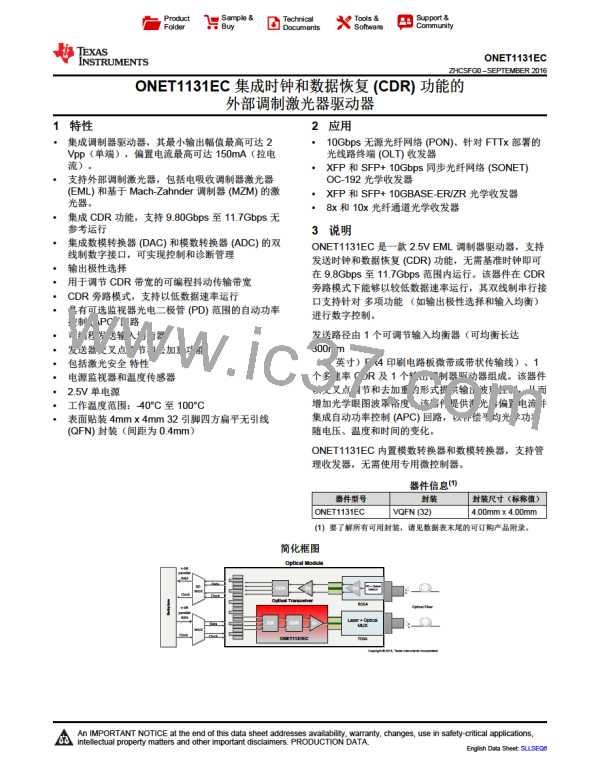ONET1131EC
www.ti.com.cn
ZHCSFG0 –SEPTEMBER 2016
Feature Description (continued)
If one or more fault conditions occur and the transmitter fault enable bit TXFLTEN is set to 1, the ONET1131EC
responds by:
1. Setting the bias current to zero.
2. Asserting and latching the TX_FLT pin.
3. Setting the TX_FLT bit (bit 5 of register 43) to 1.
Fault recovery is performed by the following procedure:
1. The transmitter disable pin TX_DIS and/or the transmitter bias current enable bit TXBIASEN are toggled for
at least the fault latch reset time.
2. The TX_FLT pin de-asserts while the transmitter disable pin TX_DIS is asserted or the transmitter bias
current enable bit TXBIASEN is de-asserted.
3. If the fault condition is no longer present, the part returns to normal operation with its prior output settings
after the disable negate time.
4. If the fault condition is still present, TX_FLT re-asserts once TX_DIS is set to a low level and/or TXBIASEN is
set to 0 and the part will not return to normal operation.
7.3.8 Analog Block
7.3.8.1 Analog Reference and Temperature Sensor
The ONET1131EC is supplied by a single 2.5 V ±5% supply voltage connected to the VCC and VDD pins. This
voltage is referred to ground (GND) and can be monitored as a 10 bit unsigned digital word through the 2-wire
interface.
On-chip bandgap voltage circuitry generates a reference voltage, independent of the supply voltage, from which
all other internally required voltages and bias currents are derived.
In order to minimize the module component count, the ONET1131ECprovides an on-chip temperature sensor.
The temperature can be monitored as a 10 bit unsigned digital word through the 2-wire interface.
7.3.8.2 Power-On Reset
The ONET1131EC has power on reset circuitry which ensures that all registers are reset to default values during
startup. After the power-on to initialize time (tINIT1), the internal registers are ready to be loaded. The part is ready
to transmit data after the initialize to transmit time (tINIT2), assuming that the enable chip bit EN_CHIP = 1 (bit 0 of
register 0). In addition, the disable pin DIS must be set to zero.
The ONET1131EC bias current can be disabled by setting the DIS pin high. The internal registers are not reset.
After the transmitter disable pin DIS is set low the part returns to its prior output settings.
7.3.8.3 Analog to Digital Converter
The ONET1131EC has an internal 10 bit analog to digital converter (ADC) that converts the analog monitors for
temperature, power supply voltage, bias current and photodiode current into a 10 bit unsigned digital word. The
first 8 most significant bits (MSBs) are available in register 40 and the 2 least significant bits (LSBs) are available
in register 41. Depending on the accuracy required, 8 bits or 10 bits can be read. However, due to the
architecture of the 2-wire interface, in order to read the 2 registers, 2 separate read commands have to be sent.
The ADC is enabled by default so to monitor a particular parameter, select the parameter with ADCSEL[0..2]
(bits 0 to 2 of register 3). Table 1 shows the ADCSEL bits and the parameter that is monitored.
Table 1. ADC Selection Bits and the Monitored Parameter
ADCSEL2
ADCSEL1
ADCSEL0
MONITORED PARAMETER
Temperature
0
0
0
0
0
0
1
1
0
1
0
1
Supply voltage
Bias current
Photodiode current
Copyright © 2016, Texas Instruments Incorporated
19

 TI [ TEXAS INSTRUMENTS ]
TI [ TEXAS INSTRUMENTS ]